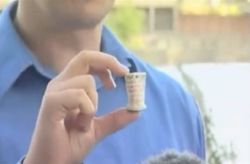Pressure and deep-sea animals: an egg-splanation
An uncooked chicken egg is not as strong as a deep-diving submersible; I can crush an egg easily with my hand.
So what happens if we send an egg down into the ocean depths?
That's what we did as an experiment during the Ocean Census Arctic Deep expedition - and the OC media team made this lovely explainer video about it:
Video by Ocean Census media team
The egg didn't implode, get crushed, or even crack at all (and we sent it down to ~3.5 km deep, which is roughly the global average depth of the ocean, and almost the depth of the Titanic).
The egg stayed intact because it consists of a solid shell containing a liquid, both of which are pretty much incompressible forms of matter.
Imagine dropping a stone into the ocean: it won't suddenly implode at any depth, because it's made of solid matter. And liquid is mostly incompressible too - try squeezing a syringe of water with your thumb over the spout, compared with a syringe of air.
So the egg is not like our deep-diving submersibles, which need to maintain a proportionally large gas-filled space inside them at surface pressure (either to keep occupants alive, or to keep electronics dry if it's an uncrewed vehicle).
The egg isn't resisting a huge difference in pressure between the deep ocean around it and what's inside it. Effectively, the pressure inside the egg is the same as the pressure around it.
Life in the deep
Like the egg, the bodies of most deep-sea animals consist of solid tissues and liquid body fluids, with no gas-filled spaces inside them.
So they don't have to withstand a huge difference in pressure between their insides and outsides either. They don't need the structural equivalent of the super-strong hulls that our undersea vehicles have to resist high pressure in the deep ocean.
You can do the same experiment with an unopened can of drink too: it will come back from the ocean depths without a dent in it, for the same reason as the uncracked egg.
That's different to what happens when we send polystyrene cups to the deep ocean and back (a popular activity on expeditions to make souvenirs). Expanded polystyrene contains air, and the pressure squeezes out that air, collapsing the polystyrene back to its "unexpanded" state, so we end up with shrunken cups to keep afterwards.

Busting some myths about bursting and blobbiness
The egg experiment also explains why most deep-sea animals don't "explode" if you bring them up to the surface. There's usually no gas inside them, just incompressible (and thereby also unexpandable) solid tissues and liquid body fluids.
(There are some deep-sea fishes that have gas-filled swim bladders for buoyancy, and if you bring one of those up faster than it can absorb the expanding gas, its swollen swim bladder pushes its guts out of its mouth. But most deep-dwelling fishes don't have gas-filled swim bladders).
The experiment also illustrates why what's often written about the blobfish needing the high pressure of the deep ocean to maintain its normal shape is nonsense. A blobfish underwater near the surface looks the same as a blobfish in the deep sea (nothing in its body expands while bringing it up).
A blobfish only becomes "blobby" if you take it completely out of the water that normally supports its largely gelatinous body (which has a reduced skeleton, as part of its energy-efficient lifestyle in the deep ocean). In that regard, it's just like a washed-up jellyfish, whose blobbiness has nothing to do with being released from the high pressure of the deep ocean.
Under pressure: the real challenge
Pressure is a challenge for deep-sea life, but not in the same overall structural / mechanical way that it is for our deep-diving vehicles.
The pressure of the deep ocean affects processes inside living cells at a molecular level. For example, it can interfere with how protein molecules fold up into the correct shape to work properly as enzymes.
And the high pressure can make the layers of lipid molecules that form the membranes of cells less fluid, which can disrupt the signals that need to pass through them.
So deep-sea organisms have adaptations to overcome those challenges of living at high pressure, but they're adaptations at a molecular level.
For example, deep-sea species sometimes have different sequences of amino acids in their proteins; some also have "chaperone" molecules that help with protein folding; and they may have differences in the composition of their cell membranes. And genomics is revealing those adaptations for living in the deep ocean that covers most of our world.
Jon Copley, April 2025
| Previous | Index | Next |



